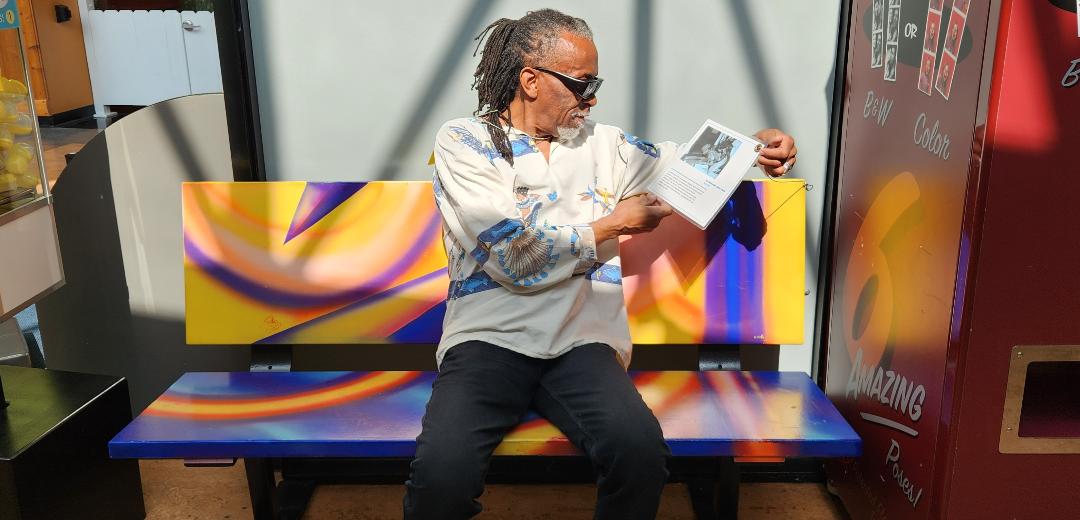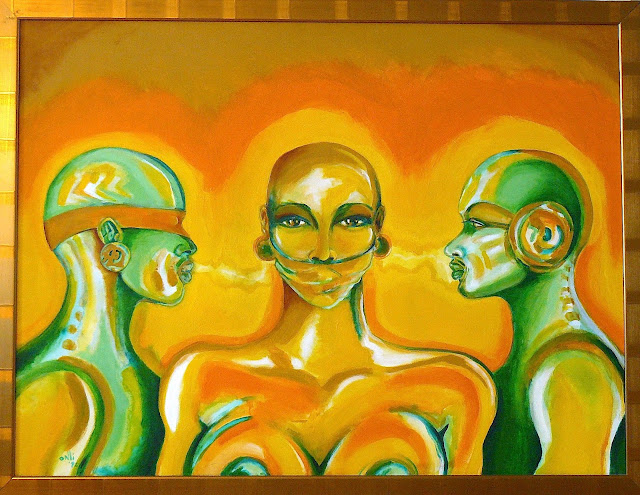He reviewed how he discovered this trait about himself in elementary school and nurtured it over his 50 plus years of being a professional/career artist.
His term "Rhythmism" addresses how the past.present/& future are always about and within the intuitive and imaginative flow of most artistic practices.
More than a style.....it is the root of his practice.
The Box Factory For the Arts knows how to promote the Arts as a vital part of community life.
Onli showing the Rhythmistic treatments he and quilter Patrick Whalen gave this traditional Teke masque icon.
During his presentation Onli went into his professor model and opened with the BBC DVD insightful feature "More Human Than Human".
MADRID (AFP).-
Researchers have discovered a series of creativity-linked genes that
may have given Homo sapiens a significant edge over Neanderthals,
enabling them to avoid extinction.
The findings suggest that these genes played "a fundamental role in the evolution of creativity, self-awareness and cooperative behaviour," the multinational research team wrote Wednesday in the Nature journal Molecular Psychiatry.
Such genes were like "a secret weapon" that gave modern humans "a significant advantage over now-extinct hominids by fostering greater resilience to ageing, injury, and disease, they wrote.
Led by Granada University in Spain, the experts identified 267 genes unique to humans, and through genetic markers, genetic expression data and AI-related MRI techniques, found they were related to creativity.
"The scientists were able to identify the regions of the brain in which those genes (and those with which they interacted) were overexpressed," they wrote.
"These regions are involved in human self-awareness and creativity, and include the regions that are strongly associated with human well-being and that appeared relatively recently."
Previously, the same team had identified a pool of 972 genes organised into three brain networks, the oldest -- which relates to learning habits, social attachment and conflict resolution -- dating back 40 million years.
The second network -- which relates to intentional self-control -- emerged 2 million years ago, while the newest, governing creative self-awareness, only emerged 100,000 years ago.
"Thanks to these genes, Homo sapiens enjoyed greater physical fitness than now-extinct hominids, providing them with a superior level of resilience to ageing, injury, and disease," they wrote.
"Physical fitness, or resilience, is intrinsic to the definition of creativity," said the study's lead author Igor Zwir.
The finding offers fresh insight into the mystery of why Homo sapiens outlived the Neanderthals and other species.
The authors said creativity may have encouraged cooperation between individuals which would have set the stage for technological innovation, behavioural flexibility and openness to exploration, enabling them to spread out more successfully than their predecessors.
© Agence France-Presse
From personal books to major Rhythmistic fine art....a life long practice yields a great deal to appreciate.
The press is often open to Onli's works. The greater challenge is having his works included in museum collections, corporate collections and collections of serious fine art collectors.
The trends and times are catching up to Onli's decades long practice as curators and art directors are becoming more accepting of his future-primitif distinctions.
A major female art collector on a studio visit questioned how Onli could depict women as natural positive powerful goddesses, not simple sex objects,..... though he is a practicing, openly heterosexual male.
She went on to say that had he been a woman or even Gay she would have purchased his artwork.
Onli thanked her for her candor and felt she spoke the logic that so many others operate with when they a dysfunctional response to him as the artist behind these impressive art works. She also added that she was impressed at how his art was legit, skilled, expressive with substance not fluff, and real.
But she still was not willing to buy from him. All to the embarrassment of the gallery owner who was at that time exhibiting Onli's works.
Hmmmm! Her lost. More enlightened collectors, curators and dealers are out there.
The findings suggest that these genes played "a fundamental role in the evolution of creativity, self-awareness and cooperative behaviour," the multinational research team wrote Wednesday in the Nature journal Molecular Psychiatry.
Such genes were like "a secret weapon" that gave modern humans "a significant advantage over now-extinct hominids by fostering greater resilience to ageing, injury, and disease, they wrote.
Led by Granada University in Spain, the experts identified 267 genes unique to humans, and through genetic markers, genetic expression data and AI-related MRI techniques, found they were related to creativity.
"The scientists were able to identify the regions of the brain in which those genes (and those with which they interacted) were overexpressed," they wrote.
"These regions are involved in human self-awareness and creativity, and include the regions that are strongly associated with human well-being and that appeared relatively recently."
Previously, the same team had identified a pool of 972 genes organised into three brain networks, the oldest -- which relates to learning habits, social attachment and conflict resolution -- dating back 40 million years.
The second network -- which relates to intentional self-control -- emerged 2 million years ago, while the newest, governing creative self-awareness, only emerged 100,000 years ago.
"Thanks to these genes, Homo sapiens enjoyed greater physical fitness than now-extinct hominids, providing them with a superior level of resilience to ageing, injury, and disease," they wrote.
"Physical fitness, or resilience, is intrinsic to the definition of creativity," said the study's lead author Igor Zwir.
The finding offers fresh insight into the mystery of why Homo sapiens outlived the Neanderthals and other species.
The authors said creativity may have encouraged cooperation between individuals which would have set the stage for technological innovation, behavioural flexibility and openness to exploration, enabling them to spread out more successfully than their predecessors.
© Agence France-Presse
From personal books to major Rhythmistic fine art....a life long practice yields a great deal to appreciate.
The press is often open to Onli's works. The greater challenge is having his works included in museum collections, corporate collections and collections of serious fine art collectors.
The trends and times are catching up to Onli's decades long practice as curators and art directors are becoming more accepting of his future-primitif distinctions.
A major female art collector on a studio visit questioned how Onli could depict women as natural positive powerful goddesses, not simple sex objects,..... though he is a practicing, openly heterosexual male.
She went on to say that had he been a woman or even Gay she would have purchased his artwork.
Onli thanked her for her candor and felt she spoke the logic that so many others operate with when they a dysfunctional response to him as the artist behind these impressive art works. She also added that she was impressed at how his art was legit, skilled, expressive with substance not fluff, and real.
But she still was not willing to buy from him. All to the embarrassment of the gallery owner who was at that time exhibiting Onli's works.
Hmmmm! Her lost. More enlightened collectors, curators and dealers are out there.









No comments:
Post a Comment